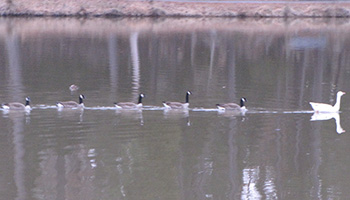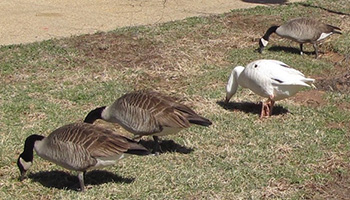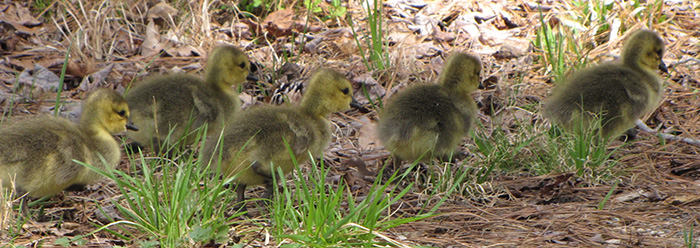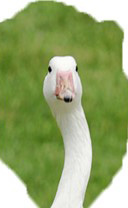Being Single is "Not for the Birds"! – Canada Geese
By the Site Ecology Team (SET) and Wildlife and Industry Together (WAIT)
February 15, 2016

Photo courtesy of Bill Willis
This update is for those of you who are still young enough to remember. The White Goose (WG), known around campus and in the local press, as Toulouse, has spent many hours at NIEHS over the course of 4 plus years. He’d usually show up on campus in late winter and hang around thru late summer.Although he’d take a few side trips to local grocery stores, Keystone, or one of the many fine 5 star-eating establishments in the Triangle, he wasn’t restricted to being here year round. He was free to “fly away” at any time. How far away was never fully resolved, but he was known to leave the county. His close companions grew in number each year, reaching 7 Canada Geese (CG) in 2014. When goslings appeared in the group, he could be seen accompanying two or three adult GC and their new family. He was initially kidded about being different and being their nanny. When faced with the prospect of an NIEHS Goose Sensitivity & Ethics Awareness Training Class, these situations ceased. That was the case in 2013 & 2104 but what happened last year to change things?

Photo courtesy of Dmitri Zaykin
Snow was still on the ground, when Toulouse returned to NIEHS on February 24, 2015. He quickly joined 5 to 7 CG to form a small social unit. He appeared to take on the role as leader. The geese could be observed playing follow the leader, swimming, dinning on fine grasses, or monitoring and controlling traffic on Lakeview Drive.

Photo courtesy of Bill Willis

Photo courtesy of Bill Willis
From the information not gathered last year, we knew not to expect any formal documents or records to turn up. Speculation and hearsay were, at best, our most reliable resources. We did have a report from Law Enforcement of a white gosling being one of a goose family about five years ago. Unfortunately, those pictures, along with his camera were stolen in a bizarre home invasion. Neither the perpetrators nor camera memory card were ever recovered. We do know that this WG has returned to campus each year and that the number of individuals in that gaggle has increased roughly by the number of chicks from the previous season. Call it speculation if you like, but we like to think of it as good family ties/bonds and confirmation that the WG is part of the bird family reunions.
It was March, things were going well, and birds were beginning to pair and to stake out their territory. A BOLO went out to EPA and NIEHS asking employees to report any evidence of mating or nesting by Toulouse (WG). There was good employee response, which allowed Toulouse to be tracked on both EPA and NIEHS campuses. He wandered both campuses with and without the other CGs. A lot of time was spent along Environmental Parkway at the circle. As the days passed, more and more geese paired, but not good old Toulouse. We were starting to get worried that he wouldn’t find a mate or vice versa. The paparazzi were restricted from campus, signage was made to rope off any nesting site, but no pairing happened. There were no reports of elevated hormone levels. No females approached him, inviting him to the big dance. It appeared that he was alone now, no longer with his family, and without a potential mate. What had changed? Was he now considered an adult (yes) and mature (yes)?
On 3/13/15, Toulouse was alone near the traffic circle about the same time that 15 vultures were circling overhead. These circumstances were out of the ordinary. He said nothing, and remained seated near the road. What did the vultures know – should I be concerned? Was this all destined to end in a “game of chicken” gone bad? It was Friday the 13th!
For the remainder of the month, Toulouse was not seen on campus. It wasn’t until 4/06/15, that he appeared at the Memorial Garden. He quickly went to the EPA near bridge #6, where he tried to join a pair of CG and their five goslings. This was the first hatching of the season. The goslings were less than a day old. Were the last couple of years to be repeated this year?

Photo courtesy of Bill Willis
When Toulouse tried to get close, the gander would chase him away. There didn’t appear to be a nest in the area, although EPA employees did report seeing eggshells near their building. Reports of sightings picked up, but in most cases the WG was near but noticeably separate from the first pair with goslings. Employees reported that the WG was getting closer to the family, but these reports weren’t consistent and never like in the previous years.
By the end of April, two more clutches had hatched, one of four and one of five goslings. Later there would be two more of three and four. Of the four nests located on the NIEHS side, all but one fell to predators. All along, Toulouse only showed interest in the first goose family. By mid-May goose numbers were fluctuating, with two CG joining the WG. They still wandered, following the first pair but the relationship that existed in the previous two years was never exhibited. June was more of the same.
The sex of Toulouse and some of his gaggle mates needed to be determined. A quick search on the Internet for goose genomic DNA sequences and species identification using sequencing didn’t show that there was much sequence to work with. But, chromosome-specific intron size differences in the avian CHD gene provided a simple and efficient method for sexing birds. Several primer pairs, that were specific for the goose sex chromosomes, did provide a way to sex-type Toulouse. Genomic DNA was extracted from molted flight feathers (quill end). Then with polymerase chain reaction (PCR) amplification, and agarose gel band separation, Toulouse was determined to be a HE, and that his gaggle was composed of HEs and SHEs. What couldn’t be determined from this primer assay was his genetic background or if he were fertile. Goose scat, for the volume of raw material that would be needed, didn’t provide a satisfactory method when considering the man-hours involved and the comments that were being generated.
After a somewhat socially disappointing summer, Toulouse was again nowhere to be found on July 4. Reports came in that he and companions had moved into the Parkside Apartments and Shopping Center at NC54 & 540. Could this gaggle be his reunited biological family? That’s where he and five Canada Geese (CG) had been seen until mid-December. There were never goslings present. The fountain aerator in the catch basin at NC55 and O’Kelly Chapel Road was a favorite attraction until management turned it off. During January 2016, he dropped off the radar again, no longer visiting the previous Parkside haunts.

Photo courtesy of Paula Juras
Due to the differences in relationships between the CG and WG this year, no banding was pursued in 2015. We may attempt to band/code birds with the assistance of the NC Wildlife in the early spring 2016 if Toulouse reforms the gaggle. This would allow tracking within the region and on migratory routes. It would also help identify the breeders and possibly help establish where these animals go upon leaving campus, should bird flu become an issue in migratory or residential populations. No leg bands have been seen on CGs for the last several years.
We have begun to learn more, but there are still questions to be answered. A special thanks goes out to all the EPA and NIEHS employees who have shared observations, pictures, and comments with the Site Ecology Team and the Wildlife And Industry Together members. Without your help, we wouldn’t have learned as much as we have.

We’ll continue to watch, learn, and evaluate in 2016. If circumstances allow, additional gDNA and mitochondrial analysis involving restriction enzyme sites may be considered and pursued.



